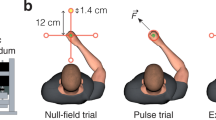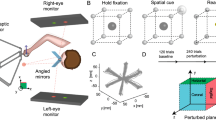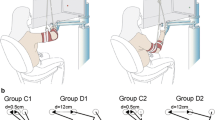Abstract.
In a recent paper, Flament et al. (1999) studied the process of learning to flex the elbow faster. They concluded from their data that time-related parameters (e.g. movement time) changed faster during learning than magnitude-related parameters (e.g. peak velocity) and discussed this finding in terms of neural substrates responsible for the apparently different learning mechanisms. In this paper, I will argue that finding different time constants does not imply different learning mechanisms and will give a theoretical example of the development of parameters during learning to move faster. Despite the fact that only one learning process is modelled, various kinematic parameters show different time courses of learning. The differences the model predicts are comparable with the experimental results.
Similar content being viewed by others
Author information
Authors and Affiliations
Additional information
Electronic Publication
Rights and permissions
About this article
Cite this article
Smeets, J. The relation between movement parameters and motor learning. Exp Brain Res 132, 550–552 (2000). https://doi.org/10.1007/s002210000409
Received:
Accepted:
Issue Date:
DOI: https://doi.org/10.1007/s002210000409




